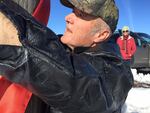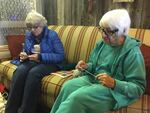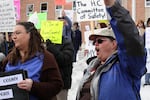
Volunteers tied orange ribbons, which are meant to symbolize unity, around Burns, Oregon, and the neighboring city of Hines.
Jes Burns / OPB
Sally Hendry set out down the highway on a 28-degree morning with an armful of thick orange ribbons meant to symbolize unity. Trudging through the snow, the retired social worker wrapped one of the ribbons around a utility pole.
"Is that high enough?" Hendry asked her friend Terry Bencen, also of Burns, as she reached up the pole.
"Should be," said Bencen, observing as Hendry tied the ribbon into a bow. "I thought you were going to do something fancy," he teased.
A small army of volunteers set out across Burns and the neighboring city of Hines on Wednesday to tie the unity ribbons along the major streets and highways.
It might seem like a minor gesture, but for these residents, placing unity ribbons is a start to bringing Burns back together.
Although the leaders of the armed occupation at the Malheur National Wildlife Refuge were arrested, Harney County remains a tense, and in some ways, a divided place.

Terry Bencen ties an orange ribbon around a utility pole to symbolize unity for the Burns community.
Amanda Peacher / OPB
Three Months Of Outsiders In Harney County
For local residents, the occupation didn't just affect the refuge. It took over daily life in Harney County.
The occupation and the issues it raised come up during basketball games, in tense conversations on Facebook and in the grocery store aisle in Hines. Rumors circulate about family riffs — and even break-ups — because people took different sides on the occupation.
Public officials and agency employees say they've been harassed and followed by militia groups, and many are uncomfortable with armed strangers who carry sidearms into the grocery store.
The reasons for the stress and the community divisions have changed over the weeks.
In November and December, Ammon Bundy and the outsiders who came to town were focused on the Hammonds, local father and son ranchers convicted of arson. Even then, the presence of the self-described militia groups was disconcerting to many in Burns.
When the Bundys and their followers took over the refuge, many residents were anxious, but that anxiety quelled some when the occupiers demonstrated that they wanted to be nonviolent. People also grew used to the militants. Some residents still vehemently wanted the Bundys to leave, but others began to listen to and appreciate the militants' message.
But earlier this month, the shooting death of LaVoy Finicum brought a new wave of militia members back to town to protest his death, and now the reasons for worry have shifted yet again.
Twenty-three-year-old Frankie Gould said having outsiders in town whom she distrusts has had a big effect on her young family. She didn't quite know what to say when her 3-year-old asked about the "strangers with big guns" in town.
Gould said she now avoids certain places in Burns.
“I feel like I don’t even want to take my kids anywhere,” said Gould. She has turned around in restaurant parking lots to avoid outsiders when she noticed out-of-state license plates filling the spots.
“I don’t even want to go in and see these people,” said Gould. “It has been a very big hassle for everybody in town.”
Those in Burns who support the militant groups feel like they’re finally standing up for an important cause.
“My community is divided,” said Jennifer Casey, who owns a ranch near Crane, Oregon. “I believe the way we go from here is through education. We educate people about their rights. People do not even know their constitutional rights anymore."
Casey said she feels the occupation has raised important questions about federal agencies.
“They’re trying to ruin a chance for my children to live the way I’ve raised them. I just feel it’s being trampled. It doesn’t mean nothing to nobody,” Casey said.
Meanwhile, Charlotte Roderique, chair of the Burns Paiute Tribe, has worried constantly over the ancestral sites and tribal artifacts stored at the refuge headquarters being trampled.
“We take our protection of our ancestors very seriously," said Roderique. “It is an emotional thing for us and it’s hard to talk about."
The tribe plans to conduct a cleansing and prayer ritual when the occupation finally ends.
Occupation Talk Dominates The Conversation
On Tuesday in Burns, a knitting club gathered at a bookstore downtown. Two white-haired women who are both named Helen knit and chatted. They used to spend this time catching up on grandkids or asking after each others' health, but now their conversation quickly turns toward the refuge occupation. Helen Hardwick said she doesn’t know anyone who supports the militants.

Helen Hardwick, left and Helen Patton talk about the refuge occupation during knitting group in Burns.
Amanda Peacher / OPB
“The people that I know, they just want them to leave, and things get back to normal again,” said Hardwick.
Helen Patton talks about
the community rally she went to the day before
. Hundreds of locals gathered in front of the courthouse for a counterprotest directed at activists with the Pacific Patriots Network.
"It made a lot of us feel better. It gave us a good opportunity to yell," said Patton. "And I think that’s what a lot of us have been wanting to do for a long time.”
An initial protest that day was organized by the Pacific Patriots Network, a self-described militia network that is sympathetic to some of the goals of the refuge occupiers but doesn’t condone the occupation. Self-described militia groups have had a presence of some kind in Burns since November.
For many in Burns, the counter protest was the first time they were able to confront outsiders about the recent turmoil in the community.
“You should’ve seen Barb Nelson,” said Patton, describing how her friend made signs and led loud chants. “Well, she doesn’t have that red hair for nothing.”

A local resident from Burns who gave her name only as "Dory" shouts "go home militia."
Amanda Peacher / OPB
The protest was intended to be silent, organizers said. But as Harney County residents came face-to-face with the outsiders, emotions boiled over.
It was as if all the anger, fright and fatigue of the past several weeks suddenly came out in a string of chants: "Go home, bullies." "Harney Strong." "Not our voice."
“Enough was enough. It was cathartic,” said Craig LaFollette, mayor of Burns. He has been among a number of local leaders who have called for the occupation to end.
He believes the community will mend but worries about the reputation of Burns going forward.
“This quiet, small community has been thrust the forefront of everyone’s daily conversation. And that’s quite unfortunate. Because there is a complete different side of this community,” LaFollete said.
While
four remaining militants linger on at the refuge
, there’s no clear sign of when the occupation will end, or what the future of Burns might look like.
People like Sally Hendry, who led the orange ribbon-tying effort, said they want to start the healing process in Burns sooner rather than later.
"It's hopefully going to be unity day in Burns today," said Hendry. "And I'm hoping — oh, I'm hoping — that this is going to lead to some resolution."